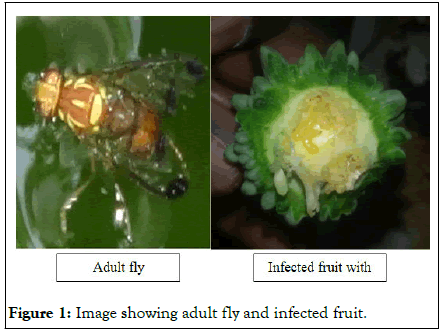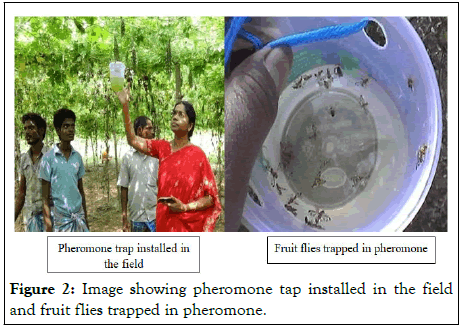Journal of Horticulture
Open Access
ISSN: 2376-0354
+44-77-2385-9429
ISSN: 2376-0354
+44-77-2385-9429
Research Article - (2023)Volume 10, Issue 1
Bitter gourd (Momordica charantia L.) is one of the most popular vegetable cultivated throughout India. Cucurbit fruit fly, Bactrocera cucurbitae (Coquillett), is one of the most important pests of cucurbits in crop growing areas. The extent of losses varies between 30% to 100%, depending on the cucurbit species and the season. It prefers to infest young, green, soft skinned fruits. It inserts the eggs 2 mm to 4 mm deep in the fruit tissues, and the maggots feed inside the fruit. Pupation occurs in the soil at 0.5 cm to 15 cm below the soil surface. Because of the difficulties associated with the control of this pest by chemical insecticides, farmers experienced great losses in cucurbits. Keeping in view the importance of the pest and crop, fruit fly management was tested under Frontline Demonstration (FLD) conducted under farmer field conditions to assess losses and to measure the efficacy of pheromone traps in trapping the adult flies. The trail resulted in 20% increase in yield along with complete reduction in the usage of chemical pesticide which was applied earlier. This resulted in reducing the cost of chemicals nearly INR. 3,000 per acre which was spent earlier.
Bactrocera cucurbitae; Cucurbita pepo; Cucurbit fruit fly; Pheromone trap; Pupation
Bitter gourd (Momordica charantia L.) is one of the most popular vegetable cultivated throughout India. The plant has nutritive and medicinal significance. However, cucurbit fruit fly Bactrocera cucurbitae (Coquillett) (Diptera: Tephritidae)] is the major limiting factor in obtaining quality fruits and a high yield. It causes heavy losses to bitter gourd. The maggots of fruit fly feed inside the fruit as well as on the fruit pulp or, occasionally, on the flowers, taproots, stems, and leaf stalks. The fruit fly, Bactrocera cucurbitae (Coquillett) (Diptera: Tephritidae) is distributed widely in temperate, tropical, and sub-tropical regions of the world. It has been reported to damage 81 host plants and is a major pest of cucurbitaceous vegetables, particularly the bitter gourd (Momordica charantia), muskmelon (Cucumis melo), snap melon (C. melo momordica), and snake gourd (Trichosanthes anguina). Its abundance increases when the temperatures fall below 32°C, and the relative humidity ranges between 60% to 70% [1].
The infested fruits and flowers do not develop properly and fall down or rot on the plant and resulting reduction in yield. Young larvae leave the necrotic region and move to the healthy tissues, where they often introduce various pathogens and hasten the fruit decomposition.
In the bitter gourd fruit, 41%-95% melon fruit fly infestation has been recorded and reported 31.27% damage on bitter gourd and 28.55% on watermelon in India. It showed that melon fruit fly showed 16%-75% infestation on the bitter gourd fruits. Conventional insecticides are being used for controlling fruit flies, organophosphates like, imidan (phosmet), triazophos, malathion and azinphos-methyl but the incidence of the pest is not under control. Considering the hazardous impact of chemicals on non-target organisms and the surrounding, the present trial was undertaken to assess the efficacy of pheromone trap aiming to develop an eco-friendly and sustainable pest management system in bitter gourd [2].
Selection of farmers
The farmers were selected based on diagnostic field visit conducted during crop season. The farmers were identified in Hanumanthapuram and Malaivaiyavur villages Chengalpattu district, Tamil Nadu, India. The main purpose of the demonstration is to popularize the use of pheromone traps to monitor the pest population and then device the control measure for bitter gourd fruit fly management [3].
Trail details
The trail was conducted in Hanumanthapuram and Malaivaiyavur villages Chengalpattu district, Tamil Nadu, India. About 10 bitter gourd growing farmers were selected and crop was sown during July month. Pandal method of cultivation was followed. Seeds were sown in pits of size 30 cm × 30 cm × 30 cm at 2 m × 1.5 m spacing. Treated seeds were sown in the pits at 5/pit. Manures and fertilizers were applied as per recommendations. Indian Institute of Horticultural Research (IIHR, Bengaluru) traps and lures were supplied as critical inputs to the farmers. Trap was installed before flowering at 6/acre maintaining the water level in the trap. The lure was replaced once in 30 days. The field with pesticide spray alone was maintained as check. Number of fruit flies per trap was recorded every week and damage was calculated and yield was recorded out of 20 harvests [4].
The incidence of fruit flies was found throughout the crop period. The trial resulted in complete control of fruit flies in pheromone trap installed plots compared to pesticide sprayed plots. The fruit infestation with flies was completely under control in trail plot. The highest incidence was noticed in trail no. 10 were chemical spray was uses. The number of fruit flies trapped per week was recorded in pheromone traps, the highest being in trail no. 7 (28 flies/trap/week) (Tables 1 and 2). The yield recorded about 20% increase in trap installed plots. This also resulted in reducing the cost of pesticide application nearly Rs.3000/- that was spend on pesticide application (Figures 1 and 2) [5].
| Trail No. | Farmer’s method of control (Pesticide spray) | FLD recommendation | |||
|---|---|---|---|---|---|
| Yield (Kg/acre) | Pest incidence % | Yield (Kg/acre) | Pest incidence % | No. of flies/trap/week | |
| 1 | 10800 | 20 | 12960 | Nil | 20 |
| 2 | 11400 | 26 | 13680 | Nil | 20 |
| 3 | 12600 | 30 | 15120 | Nil | 21 |
| 4 | 12240 | 25 | 14866 | Nil | 25 |
| 5 | 11700 | 27 | 14040 | Nil | 22 |
| 6 | 11100 | 24 | 13320 | Nil | 21 |
| 7 | 12900 | 28 | 15480 | Nil | 28 |
| 8 | 13200 | 23 | 15840 | Nil | 23 |
| 9 | 11760 | 31 | 14112 | Nil | 24 |
| 10 | 12300 | 35 | 14760 | Nil | 26 |
| * | 12000 | 26.9 | 240 | Nil | 22.8 |
| *Average of the data | |||||
Table 1: Bitter gourd fruit fly management.
| Trail No. | Farmer’s method of control (Pesticide spray) | FLD recommendation (Pheromone trap installation) | ||
|---|---|---|---|---|
| Gross cost*Rs. | Gross return**Rs. | Gross cost Rs. | Gross return Rs. | |
| 1 | 81000 | 194400 | 77500 | 233280 |
| 2 | 75000 | 205200 | 72000 | 246240 |
| 3 | 82000 | 226800 | 76000 | 272160 |
| 4 | 84000 | 220320 | 80500 | 264384 |
| 5 | 82000 | 210600 | 78000 | 252720 |
| 6 | 85000 | 199800 | 80000 | 239760 |
| 7 | 85000 | 232200 | 80000 | 278640 |
| 8 | 83000 | 237600 | 79500 | 285120 |
| 9 | 83500 | 211680 | 80000 | 254016 |
| 10 | 85000 | 221400 | 81500 | 265680 |
| 82550 | 216000 | 78500 | 259200 | |
| *Cost includes field preparation, seed, fertilizers, pesticides and harvesting cost; **Returns includes yield cost with 60 kg/bag with 20 harvest/trial. | ||||
Table 2: Cost of production.

Figure 1: Image showing adult fly and infected fruit.

Figure 2: Image showing pheromone tap installed in the field and fruit flies trapped in pheromone.
The trail conducted showed effective fruit fly management in bitter gourd. There was no incidence of pest that might be due to reduction in egg laying capacity of the female flies. Similar results have been presented by Atanu Rakshit, et al., where pheromone traps were assessed against fruit fly in sweet gourd. Ramsamy et al., and Zaman have reported that Methyl eugenol and cue-lure traps attract B. cucurbitae males from mid-July to mid-November that have been used for many years to control different fruit flies. Nasiruddin et al., concluded that bait traps dispensed with pheromone or indigenous materials were highly effective for fruit fly management in cucurbit crops. Similar results have been reported by Sapkota et al., fruit flies in spring summer squash. Chowdhury et al., captured 2.36 flies/trap/day to 4.57 flies/trap/day in poison bait traps containing trichlorfon in bitter gourd. Cue-lure traps have been used for monitoring and mass trapping of the melon fruit flies in bitter gourd [6].
Keeping in view the importance of the pest and crop, the melon fruit fly can be managed or suppressed locally at the growers fields using any of the option combinations available including, bagging of fruits, field sanitation, cue-lure traps, spray of protein baits with toxicants, growing fruit fly-resistant genotypes, augmentative releases of biological control agents, and soft insecticides. On the other hand, the incorporation of a number of different techniques including the sterile insect technique, transgene based embryo-specific lethality system, and quarantine, in addition to the available local area management options, could be exploited for better results in wide area management of melon fruit fly. The local area management aims mainly at suppression, rather than eradication. Uses of wide area management to coordinate and combine different parts of an insect radication program over an entire area, within a defensible perimeter, can subsequently protect against reinvasion by quarantine controls. The use of a geographical information system could also be used as an IPM tool to mark site-specific site-specific locations of traps, host plants roads, land use areas and fruit fly populations within a specified operational region. Although, sterile insect programs have been successfully used in area-wide approaches, more sophisticated and powerful technologies should be used in their eradication program such as insect transgenesis, which could be deployed over wide areas.
Citation: Subbiah G (2023) Management of Cucurbit Fruit Flies in Bitter Gourd by Pheromone Trap–A Success Story. J Hortic. 10:007.
Received: 08-Feb-2023, Manuscript No. HORTICULTURE-23-21752; Editor assigned: 10-Feb-2023, Pre QC No. HORTICULTURE-23-21752 (PQ); Reviewed: 24-Feb-2023, QC No. HORTICULTURE-23-21752; Revised: 18-Apr-2023, Manuscript No. HORTICULTURE-23-21752 (R); Published: 25-Apr-2023 , DOI: 10.35248/2376-0354.23.10.007
Copyright: © 2023 Subbiah G. This is an open-access article distributed under the terms of the Creative Commons Attribution License, which permits unrestricted use, distribution, and reproduction in any medium, provided the original author and source are credited.
Sources of funding : &opy; 2023 Subbiah G. This is an open-access article distributed under the terms of the Creative Commons Attribution License, which permits unrestricted use, distribution, and reproduction in any medium, provided the original author and source are credited.